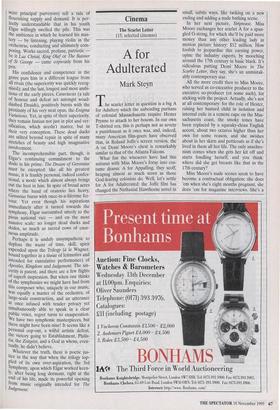Cinema
The Scarlet Letter (15, selected cinemas)
A for Adulterated
Mark Steyn
The scarlet letter in question is a big A for Adultery which the unbending puritans of colonial Massachusetts require Hester Prynne to attach to her bosom. In our own T-shirted era, this is perhaps not as severe a punishment as it once was, and, indeed, many American film-goers have observed that, in Roland Joffe's screen version, the A on Demi Moore's chest is remarkably similar to that of the Atlanta Falcons.
What fun the wiseacres have had this autumn with Miss Moore's foray into cos- tume drama: A for Appalling, they scoff, heaping almost as much scorn as those God-fearing colonists do. Well, let's settle for A for Adulterated: the Joffe film has changed the Nathanial Hawthorne novel in small, subtle ways, like tacking on a new ending and adding a nude bathing scene.
In her next picture, Striptease, Miss Moore exchanges her scarlet A for a span- gled G-string, for which she'll be paid more money than any other leading lady in motion picture history: $12 million. How foolish to jeopardise this earning power, opine the industry experts, by mooching around the 17th century in basic black. It's ridiculous putting Demi Moore in The Scarlet Letter, they say, she's an unmistak- ably contemporary star.
All the more credit then to Miss Moore, who served as co-executive producer to the executive co-producer (or some such), for sticking with the project. Actually, she's not at all contemporary: for the role of Hester, raising her bastard child in isolation and internal exile in a remote cape on the Mas- sachusetts coast, the smoky tones have been replaced by a squeaky-clean English accent, about two octaves higher than her own for some reason, and she swishes about in her skirts and petticoats as if she's lived in them all her life. The only anachro- nism comes when she gets her kit off and starts fondling herself, and you think: where did she get breasts like that in the 17th century?
Miss Moore's nude scenes seem to have become a contractual obligation: she does 'em when she's eight months pregnant, she does 'em for magazine interviews. She's a sort of Jehovah's Witness of stripping actresses. 'Look, really, no thanks, I'd rather not,' you say, hastily, but she's already jammed one nipple through the door. For many films, the bizarre evolution of her own body marked the only dis- cernible difference in her performance. If you cast your mind back to the girlish form cavorting in About Last Night a decade ago, you can understand why Demi looks so bemused examining herself here: put the two scenes side by side and I seem to hear the old Yankee advice to passing motorists, `You can't get there from here.'
Possibly this is what intrigues Gary Old- man as the Reverend Dimsdale. The Min- ister goes to minister to Hester after her husband has been reported missing in action, and, having been missing any action of his own for quite some while, winds up rolling in the hay (literally) with her. In an interesting period touch, Oldman has dirty fingernails. Otherwise, it's the usual shtick: in recent films, whether he's playing Beethoven or Dracula or a pilgrim father, he lapses into the same persona — a minor long-haired rock star with a skin problem; he wears period costume as if it's a cute novelty his producer's come up with for the new video. Forget Demi; it's Oldman who's the strictly contemporary player. Back in the Fifties, critics used to hammer Tony Curtis for wandering through mediaeval Europe in coloured tights doing his 'Yon- duh lies duh castle of my fadduh' routine. But at least the guy was making an effort. These days, Oldman and other fashionable actors — especially Brits — affect an offhanded hipness indifferent to considera- tions of time and place.
Defenders of the film keep talking about how you have to do The Scarlet Letter for `today', how you have to get around the fact that it's a 'period piece'. But The Scar- let Letter has always been a period piece. Hawthorne wrote it in 1850, when the American reading public in the prosperous Yankee industrial towns and in the prairie settlements out west was already a million miles from its puritan forebears. The advan- tage they had on us is that they hadn't lost their capacity for historical imagination. In the book and the 1926 film version with Lillian Gish, it's taken for granted that this world is interesting on its own terms.
Joffe's adaptation doesn't share that con- fidence: it spends its time trying to scratch what modish nuggets it can — a touch of proto-ferninism here, a soupcon of a woman's right to choose here. But, because Oldman can't be bothered to create the character as a man of his time, the Rev- erend Dimsdale winds up as a wimpy do- nothing. Not until Robert Duvall shows up, as the unfortunately non-deceased hus- band, does the film flare into life. In a splendid display of starry one-upmanship, Duvall also does nude scenes — though, having acquired old habits from the Injuns, he's wont to shave his belly during them. Don't give Demi ideas, Bob.



















































































 Previous page
Previous page